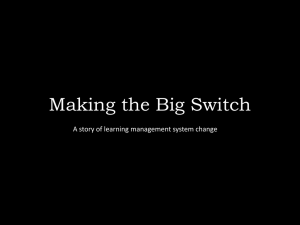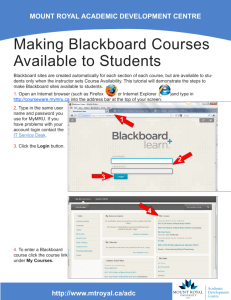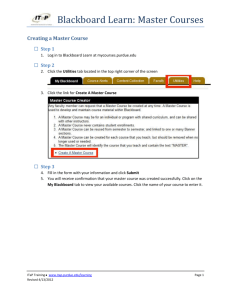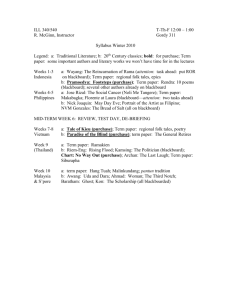MINUTES MEETING TYPE/TITLE: Distance Learning Re
advertisement
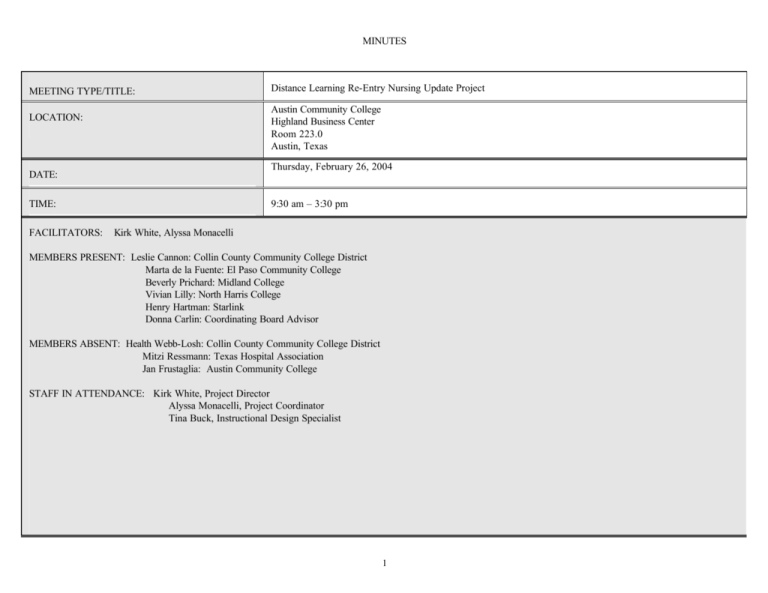
MINUTES MEETING TYPE/TITLE: Austin Community College Highland Business Center Room 223.0 Austin, Texas LOCATION: Thursday, February 26, 2004 DATE: TIME: FACILITATORS: Distance Learning Re-Entry Nursing Update Project 9:30 am – 3:30 pm Kirk White, Alyssa Monacelli MEMBERS PRESENT: Leslie Cannon: Collin County Community College District Marta de la Fuente: El Paso Community College Beverly Prichard: Midland College Vivian Lilly: North Harris College Henry Hartman: Starlink Donna Carlin: Coordinating Board Advisor MEMBERS ABSENT: Health Webb-Losh: Collin County Community College District Mitzi Ressmann: Texas Hospital Association Jan Frustaglia: Austin Community College STAFF IN ATTENDANCE: Kirk White, Project Director Alyssa Monacelli, Project Coordinator Tina Buck, Instructional Design Specialist 1 TOPIC DISCUSSION I. Welcome and Introductions Introductions of group members present, explanation of parking permits, reimbursement for travel and InKind documentation. II. Project Update Update on status of project, reviewed report (attached). Highlights of project developments since November meeting include: 1. Textbooks determined 2. Review of “Required and Optional Text-Additional Resources” list. 3. Review of Project Update Report • Question and discussion regarding hospitals providing the course. Should they be allowed to provide the course or should students be referred to the local community college? The following reasons were provided and discussed: 1. For state reimbursement 2. To keep Community Colleges name out in the communtiy 3. Retain ownership of the program 4. Protection of student to insure proper clinical placement and training is completed. 5. Insurance- will the student be properly insured as a student in the hospital setting? • It was noted the original intent of the grant 2 DECISION/ACTION Noted: Grant budget includes monies to purchase books for pilot students. Dr. Lilly reports having a colleague who has developed a website with multiple links for dosage calculations under a grant. She will forward this website for placement on the resources list or within the dosage calculations modules. was for the community colleges to partner with the local hospital for the clinical. Decision: The group would like to keep the didactic piece of the course available only through the local communtiy colleges and not through the hospitals. Partnerships will need to be established and encouraged with local hospitals to insure proper clinical training/preceptorship. Wording on paragraph 3 of the project update report will be changed to reflect above and typos on 2nd page are noted and corrected. 4. Review of the Course Framework A copy of the course framework was reviewed and discussed. Some changes had been made and were noted: • Unit 1- changed to “Orientation” • Subsequent Units were number (see attached) • Unit 3- “Nursing Skills” was changed to “Care of the Client” , module 4 changed from “The Surgical Client” to “The Surgical Client/Perioperative Care”, a module will be added – “Module 9: Care of the Cancer Patient” and will focus on safety issues. • It was recommended to move Unit 6: Professional Nursing Practice. Make Unit 6 Unit 1, Pharmacology Unit 2 and Systems Review Unit 3. For the pilot require students complete the first 3 units before beginning preceptorship. After the pilot, it will be left up to the individual schools regarding when to allow students to begin preceptorship. • Self- Assessment Discussion: Where should this be placed…prior to registration or after. 5. Continuation of Grant- 2nd year A continuation letter was sent to the Coordinating Board to notify of intent to request for additional funding for year 2 of this project. This was done via Kirk White and Donna Carlin. 3 Changes noted and revised on the course framework document (see attached). The Self-Assessment will be made available from the project website and students will be asked to complete, print, and add to pre-requisite documentation. NOTE: Include quizzes throughout modules (Unit: Systems Review) in preparation for the Unit Post-Test. Application for 2nd year funding would be made under professional development. Currently the grant oversight is through the Leadership Consortium for Curriculum Development. STARlink is scheduled to broadcast The Annual Perkins Grant Update March 3 from 1:30-2:30 pm. Kirk and Alyssa will follow-up with the broadcast in preparation for year 2 application funding requests. 6. Marketing/Announcement of On-line Course: Kirk is scheduled to present this project at the 2004 Seamless Transitions State Conference March 4 in Dallas. • The project website has been advertised to TACE, TACTE, and THA members. We have requested a link be placed on the Texas State Leadership Consortium for Curriculum Development website. • Kirk will be submitting application/proposal to present at the Fall NCCET (Nat’l Council for Continuing Education Training) conference in Portland, Oregon. • Suggestions for other conference presentations/marketing ideas - November 7- TACSCE (Texas Association for Community Service and Continuing Education) - Spring 05- TACE (Texas Administrators of Continuing Education ) Kirk will follow-up with conference applications and proposals. 7. WECM course follow-up: Beverly was successful in adding the clinical course for the RN Re-entry to the WECM. 8. Kirk (and Beverly, Donna, Alyssa) presented a project update to the Texas Leadership Consortium for Curriculum Development (they oversee this Perkins grant project) in January. From all reports, our project update/report was well received. 4 III. Course Content Development Question/Discussion: How would the group like to begin reviewing the content? As each unit is developed (Unit by Unit) or wait until entire course is completed and then review (all at once)? Do we need a faculty review committee? There are several individuals on this committee, the advisory committee, and the ACC current instructors to assist with this process. They include: • • • • • • • • IV. STARLINK Broadcast/ Informational Program Planning Dr. Vivian Lilly (may forward to a faculty member at North Harris College) Kirk White Leslie- forward to Dr. Nell Ard (Collin County) Donna Carlin Sally Samford (current ACC refresher instructor) Trish Christianson- Tarrant County College (advisory group) Lula Westrup Pelayo- San Antonio College Bonnie Schranner – University Health System (San Antonio) Questions: 1. How will the students register for the course? 2. For the pilot, could we pay the student’s insurance? 5 Will review unit by unit. Leslie / Heather can begin posting after March 15th . Content will be posted on the project website and will only be able to be viewed by this group and content reviewers. Deadlines for reviews of content will be given to keep the development process moving. No formal faculty committee will be formed. Between the project development team and the advisory group, there should be enough nurses providing expert content feedback. Pilot students will register through ACC. After the pilot, students will register through their local community college/VCT registration process. Pilot students will not be charged a tuition and cost of books will be covered by grant monies. ACC will issue the didactic certificate once the course is completed. The host college will issue the certificate for the preceptorship/clinical. It is not known if grant monies can be used to cover insurance. Donna will check with the coordinating board. 3. Can we have student pay to take the pilot? 4. What about technical support for the student? The pilot is a test mechanism. The coordinating board said this would not be possible. ACC will provide support related to Blackboard. The host college will need to provide services related to getting on the web. NOTE: ACC Blackboard support is M-F 8:00 am – 5:00 pm, business hours. There is no support after hours, students must wait until 8:00 am next business day. There is Blackboard support within Blackboard in the form of on-line manuals on how to navigate Blackboard. This information will be placed within the orientation piece of the course. 5. How will a student get into Blackboard? Students will be given a access code to access Blackboard through the project website. 6. Will testing be on-line or will student go to a testing center? Informational Program Planning: 1. Target Audience- Review of identified target audience….is there missing targets? Discussion of who we would want to include in the target audience. Most can be reached via email. 6 On-line Target Audience: • TACE- continuing education coordinators in community colleges in Texas • School of Nursing Faculty • Nurse Educators in hospitals (there may be an association for this- Alyssa will check into) • Nurse Recruiters/Human Resource Personnelreached via THA • Texas Workforce Commission • Employment Agencies- Staffing Agencies- job placement person at colleges may be of assistance here • Long Term Care Facilities-Beverly reports there is an association, she will locate and forward information. • Board of Nurse Examiners (BNE) • • • • 2. How will we inform the target audience of the program and how will they access? Discussion / explanation per Henry on offering program both streamed (where individuals can sit at their PC and view broadcast) and satellite (individuals must travel to a specified location- community collegeto view broadcast). The live broadcast can be interactive with call-in for questions. NOTE: The program can be placed on the project website after the live broadcast. Marketing of the program includes: 1. STARlink creates a flyer early (should be soon, within next month or two) and email out to community colleges. 2. 1 month before the program STARlink will send out announcement to all colleges 3. 1 week before broadcast, print packet is developed and made available via website, downloadable and printable. Packet can include: a. the basics, print packet = broadcast program ex: PowerPoint slides + evaluation or b. the basics plus additional material not presented in the broadcast. Email announcements and contacts will need to be established to invite potential attendees to the communtiy colleges to view the broadcast. 3. Target Date/Time for the Broadcast Before or after the pilot? NOTE: must be completed within the grant year. Suggestion: Conduct the program in July after pilot students have had a chance to work through parts of 7 TNA (Texas Nurses Association) TOADN TAVNE TONE (Texas Organization of Nurse Executives) the course. Question/Discussion: Will people be around in July to attend? Many faculty go on vacation in early August so July would most likely be ok. 4. Content Review/Development Review of the outline. Discussion on the content. Suggestions: • Project Overview should be short, focus on benefits of the project. • Access and Utilization should be thorough and be the emphasis of this broadcast. Step by step process. • Explanation of VCT- should include date for posting on VCT and lease fees. • Include a student testimonial Decision: Target Date: July 27 or 28, 2004 Format: Stream and Satellite, Call in with questions Location: Shoot from Dallas Content: Include testimonial from pilot student, emphasize how to access and use the course (step-bystep), may demonstrate or show part of a module/unit. Time: 1 hour (45 minutes of content, 15 minute Q&A), 1:30 pm – 2:30 pm central time. Project Group will check professional calendars and confirm availability of above dates. Group members need to check with the Distance Learning / STARlink individuals in their community colleges for room availability on those dates. Henry will pull together a production timeline and marketing plan. Tenative Timeline: • March/April- generate an email announcement for sending out to groups of individuals (TACE, THA members, etc.). This announcement should include an email address to send questions too so that these questions 8 • • • may be answered via the broadcast. End June- Information to STARlink representatives July 1- need packet information July 6- production elements completed NOTE: Idea…build into the 2nd year proposal another broadcast program or product targeting students, could place in catalogs, etc. V. Demonstration The clinical video vignettes were shown and the sample template of Unit 6 demonstrated and previewed. Discussion over requirements for the course. The demonstration contained the following links which would serve as the main links for the entire course: • • • • • • • Objectives Reading Lesson Practice Discussion Board References Post-Test for each unit The group discussed requiring the practice and the discussion board vs. having these links as optional. It was suggested to use a variety of learning styles including 1. Discussion boards which can be similar to writing assignments. The student is asked to critically think through a situation and post their thoughts, ideas, opinions, how they would handle, etc. Suggestion: The course instructor could post virtual office hours. A time would be designated by the instructor in which they would be available for live 9 It was decided to require the discussion board for some units/activities and make it optional for others depending on the content and objectives needing to be met. chat. Suggestion: Add a counseling component that would include “how to survive” – this could be a discussion board with tips for survival and encouragement for students. VI. Delivery of Course The counseling component/discussion board may be something to add in Year 2 of the grant project, would require evaluation and on-going instructor monitoring. Blackboard: Portal vs. Contained Entirely Within Blackboard. Pros and cons of using Blackboard discussed. Demonstration of courses build using Blackboard only as a portal. Approx 10% of course is held within Blackboard and 90% is on the web in HTML pages. If Blackboard would go down, the course would still be accessible vs. if the course was entirely build in Blackboard and the Blackboard server would go down, the course would not be accessible. Discussion whether to password protect the course pages outside Blackboard. This is an added layer for the student to process through but the content would be protected from individuals accessing and stealing. There could be a copyright disclaimer placed on every page to discourage stealing. NOTE: Syllabi have a disclaimer. Concern for the purchased vignettes that may be streamed. These vignettes are being sold by the ACC Dept. of Nursing and they have been advised that the vignettes would be password protected. Tina reports there would be methods of securing the vignettes if we did not want to password protect the pages outside Blackboard. VII. Pilot Testing I. Question: What about nurses wanting to take the course that may not be physically able to care for patients in today’s healthcare environment? Discussion: On the Clinical Placement Checklist there is a statement under “Other Conditions” where the 10 Decision: Course will be build outside of Blackboard using Blackboard as the portal. The pages with the vignettes will be formatted for more security. is a statement under “Other Conditions” where the student is asked to report any physical limitations that would interfere with the safe delivery of patient care. There could be a skill’s requirement developed as a pre-requisite to the course. Several committee members have seen this in other courses. Alyssa will follow-up with ACC nursing program to see what is currently in place. Marta will forward the El Paso Community College procedure to Alyssa. Leslie will forward the Collin County Community College District procedure (statement used in the nursing program). II. Review of Pilot Eligibility Check List Need to add a signature line, a statement regarding clinical requirements varying from institution to institution, remove HIPAA training statement, remove hospital orientation and confidentiality statement. Changes noted and revised eligibility checklist is attached. III. Demographic of Pilot Students Discussion regarding number of students and licensing of students needed to properly assess the course in the pilot. Pilot Test will include: LVN’s- at least 2 RN’s- 10 2 Students will need to be on 56K modem. 2 students from the following colleges (representative from the project team): ACC, El Paso, Midland, Collin County, North Harris. IV. Time line for pilot: Discussion on pilot timeline. Will be shorter than the 16 week course but because of needing to finish the pilot within the grant year, the pilot must be completed by end of August. Target Pilot Date: June 14, 2004-August 20, 2004. 11 VIII. Next Meeting Will plan to meet in Dallas at the STARlink broadcast. Alyssa will send out email within next couple of weeks so everyone can schedule their calendars accordingly. 12
